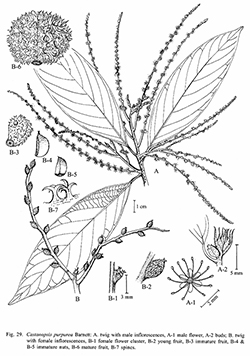e-Flora of Thailand
Volume 9 > Part 3 > Year 2008 > Page 229 > Fagaceae > Castanopsis
26. Castanopsis purpurea Barnettwfo-0000814876
Bull. Misc. Inform. Kew 1938: 105. 1938; Quer. Rel. Fag. Asia: 177. 1940; Trans. & Proc. Bot. Soc. Edinburgh 34: 336. 1944. Fig. 29; Plate XXIII: 2.
Accepted Name : This is currently accepted.
Description : Tree, 6–25 m high, 60–150 cm girth. Terminal buds ovoid, 4–5 by 3 mm, sparsely pubescent. Twigs pubescent to glabrescent, with round lenticels. Bark deeply furrowed, brown to greyish-brown, defoliating in small flakes; inner bark yellowish to pinkish-brown, with white stripes. Leaves oblong, elliptic or obovate, 10–25 by 3.2–6.3 cm; base slightly acute or obtuse, asymmetrical; apex acute, acuminate, sometimes obtuse;margins entire; subcoriaceous, glabrous and glossy dark green on the upper surface, sparsely pubescent on the lower; midrib and lateral nerves prominent on the lower surface, depressed on the upper; lateral nerves 8–11 pairs, conspicuous on the upper surface, scalariform veins distinct on both sides. Petiole 1.5–4 cm, pubescent then glabrescent, blackish when dry. Inflorescences male and female separate or mixed, erect, terminal or axillary. Male inflorescence always branched, spikelets 8–15 cm long, pubescent. Male flowers yellow, scented; bracts and bracteoles ca 1.5 by 1 mm, pubescent outside, always in 2–3-flowered cluster; calyx 6-lobed, lobes spathulate or oblong, ca 1 by 0.5 mm, glabrous; stamens 12, 2–2.5 mm long, glabrous; rudimentary ovary globose, flattened on top, ca 1 mm in diam.; hirsute. Female inflorescence spike or 1–2 branched, spikelet 5–15 cm long, pubescent, solitary or in (1)–3-flowered cluster, other characters as in male flowers; styles 3, divergent; stigmata pointed. Fruits globose, 4.5–6 cm in diam. (including cupule), fruit stalk 2–5 mm long, on erect woody infructescence 10–25 cm long. Cupule completely enclosing the nut but not fused with it, inner part with adpressed, white, silky hairs, wall sparsely covered with woody, branched, curved spines; dehiscent. Nuts 1–3(4) per cupule, ovoid and compressed along one longitudinal side, 2–3 by 1 cm, sparsely, adpressed white hairy.
Thailand : NORTHERN: Chiang Mai, Chiang Rai, Lampang, Tak; NORTH-EASTERN: Nong Khai, Nakhon Phanom; EASTERN: Ubon Ratchathani; PENINSULAR: Ranong, Phangnga, Trang (type: Kerr 19011), Songkhla.
Distribution : Endemic to Thailand.
Ecology : Tropical evergreen rain forests, dry evergreen forests, mixed deciduous forests, often near streams, 50–1,300 m (most commonly 100–800 m). Flowering: February, November (most commonly March–August); fruiting: August–October (most commonly July August).
Vernacular : Ko ti (ก่อตี), ko sai (ก่อทราย), ko ap (ก่อแอบ), ko yum (ก่อหยุม), ko nam (ก่อหนาม), ko ta mu (ก่อตาหมู), ko lim (ก่อลิ่ม)(Northern); ko khao (ก่อเขา)(Eastern); ko dan (ก่อดาน), ko nam (ก่อหนาม), be-ra-ngae-ba-bi (เบราแง้บาบี)(Peninsular).
Uses: Nuts edible.


